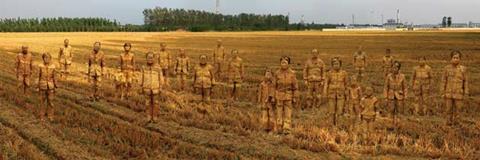Philip Ball considers Chinese works of art that comment on environmental and chemical issues
When I first saw Liu Bolin, I didn’t see him at all. The Chinese artist has been dubbed the ‘invisible man’, because he uses extraordinarily precise body-painting to hide himself against all manner of backgrounds: shelves of magazines or tins in supermarkets, government propaganda posters, the Great Wall. What could easily seem in the West to be a clever gimmick becomes a deeply political statement in China, where invisibility serves as a metaphor for the way the state is perceived to ignore or ‘vanish’ the ordinary citizen, while the rampant profiteering of the booming Chinese economy turns individuals into faceless consumers.
Hidden meaning
Recently, Liu has commented on the degradation of China’s environment and the chemical adulteration of its food and drink. Some of these images are displayed in a new exhibition, A colorful world?, at the Klein Sun Gallery in New York, which opened on 11 September.

The title refers to ‘the countless multicoloured advertisements and consumer goods that cloud today’s understanding of oppression and injustice’. But it’s not just their vulgarity and waste that Liu wants to point out – in China, the garish packaging has sometimes concealed a much more direct threat. The packaging conveys ‘a lighthearted feeling of joy and happiness, but what they truly provide is hazardous to human health’, runs the exhibition’s press release, recalling recent food scandals in China. In 2008, some leading brands of powdered milk and infant formula were found to contain melamine, a toxic carcinogen added to boost the apparent protein content and so allow the milk to be diluted without failing quality standards. Melamine can cause kidney stones, and several babies died from the condition, while many thousands were hospitalised.
There have been several other cases of foods treated with hormones and hazardous cosmetic additives. The most recent involves using phthalate plasticisers as cheap replacements for palm oil in soft drinks. These compounds may be carcinogenic and are thought to disrupt the endocrine and reproductive systems by mimicking hormones. In his 2011 work Plasticizer, Liu ‘disappeared’ in front of supermarket shelves of soft drinks.
There is no knee-jerk chemophobia in these works. They represent a genuine attempt to highlight the lack of accountability and malpractice exercised within the food industry – and not just in China. The same is true of Liu’s Cancer village, part of his Hiding in the city series in which he and others are painted to vanish against Chinese landscapes. The series began as a protest against the demolition of an artists’ village near Beijing in 2005 – Liu vanished amongst the rubble – but Cancer village illustrates the invisibility and official ‘non-existence’ of ordinary citizens in the face of a much more grievous threat: chemical pollution from factories. This seems likely to be the cause of a massive increase in cancer incidence in the village of 23 people who Liu and his assistants merged into a field behind which a chemical plant looms.
Seeing red
Such politically charged performance art walks a delicate line in China. Artists there have refined their approach to combine a lyrical, even playful obliqueness – less easily attacked by censors – with resonant symbolism. When in 1994 Wang Jin emptied 50kg of red organic pigment into the Red Flag Canal in Henan province for his work Battling the flood, it was a sly comment not just on the uncritical ‘Red China’ rhetoric of the Mao era (when the canal was dug) but also on the terrible bloodshed of that period.
It could equally have been a statement about the lamentable state of China’s waterways, where pollution, much of it from virtually unregulated chemicals plants, has rendered most of the river water fit only for industrial uses. Yin Xiuzhen’s 1995 work Washing the river stacked blocks of frozen water from the polluted Funan river on the river’s banks. Passers-by were invited to ‘wash’ the ice with clean water, echoing the purifying ritual of baptism. This year Yin has recreated Washing the river on the polluted Derwent River near Hobart in Tasmania, Australia.
These are creative and sometimes moving responses to problems with both technological and political causes. They should be welcomed by scientists, who are good at spotting such problems, but sometimes struggle to elicit a public reaction to them.












No comments yet